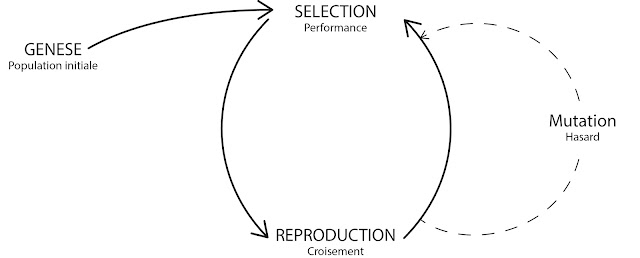It is not the strongest of the species that survives, nor the most intelligent, but the one most responsive to change. (Charles Darwin)
Principe schématique d'un algorithme génétique
Schematic principle of a genetic algorithm
Les algorithmes génétiques appartiennent à
la famille des algorithmes évolutionnistes. Ils permettent d'approcher
la ou les solutions d'un problème d'optimisation en appliquant la notion
de sélection naturelle.
L’algorithme crée un panel de solutions
initiales aléatoire (genèse). Cette population est analysée et triée
selon un critère de performance (sélection), la population « élite » est
conservée, subit des modifications (mutations)
puis est croisée avec elle-même (reproduction) pour donner naissance à
une nouvelle population « élite » plus performante. Ensuite la boucle
(Sélection, reproduction, Mutation) est répétée jusque tendre vers la
solution au problème.
Genetic
algorithms belong to the family of evolutionary algorithms. They allow to
approach a or many solutions of an optimization problem by applying the concept
of natural selection.
The
algorithm creates a panel of random initial solutions (genesis). This
population is analyzed and sorted according to a performance criterion
(selection), the "elite" population is retained, submitted to some
changes (mutations) and then is crossed with itself (reproduction) to give
birth to a new population "elite" with a higher performance. Then the
loop (selection, reproduction, mutation) is repeated until tending to the
solution of the problem.
L'outil de base d'algorithme génétique dans grasshopper est galapagos (en cours de résolution de système sur l'image)
The basic genetic algorithm in grasshopper is galapagos (the picture show the work in progress)
The basic genetic algorithm in grasshopper is galapagos (the picture show the work in progress)


Aucun commentaire:
Enregistrer un commentaire